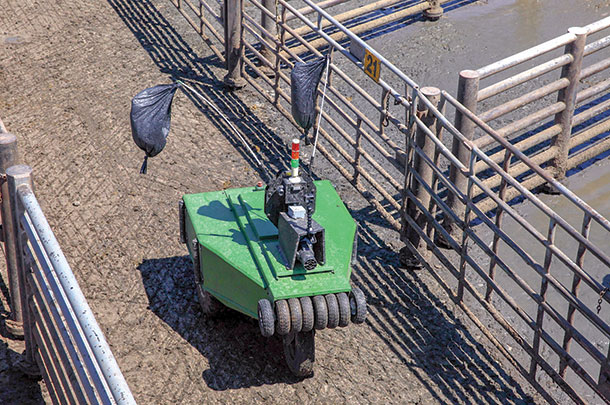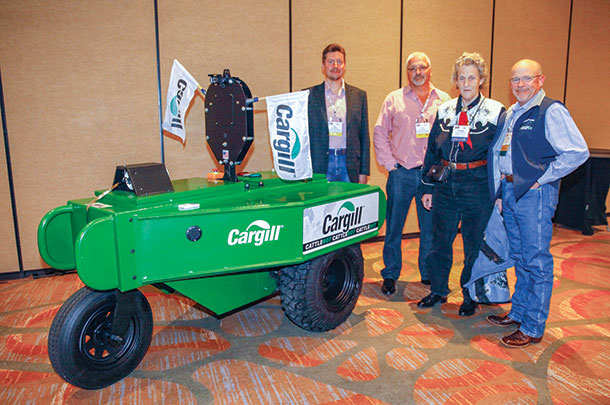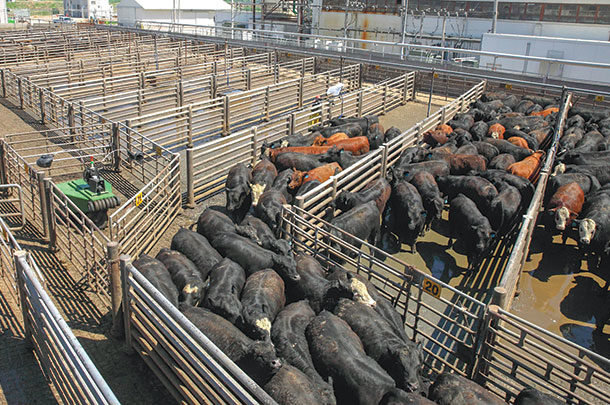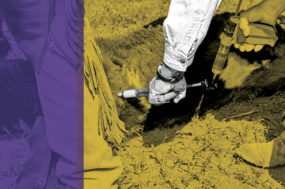Brad Churchill, director of beef slaughter operations at Cargill, is passionate about employee safety. His employees working with cattle at packing plants try to keep fences between themselves and 1,750-pound steers. However, humans drive cattle into the plant. In seconds, these unpredictable animals can whip around to charge workers, sometimes causing horrible accidents.
Several years ago, Churchill viewed a video of a Russian robot built for the security business. He immediately knew this gizmo could prevent injuries. He worked with a design team from Flock Free, a Lakewood, New Jersey, company that produces commercial and industrial bird control gadgets. After developing several prototypes, Cargill’s final robot is impressive.

Painted Cargill green, this cattle-moving machine weighs 450 pounds and measures 4 feet wide, 4 feet long and 5 feet tall. With a three-wheel configuration, this agile device pivots on a dime, quickly moving forward or backward. A center post has fixed arms which operators can remotely control to wave flags to help drive cattle. Two cameras record front and rear views, respectively.
“We also have a light,” Churchill explains. “It works at night when we’re moving cattle out in the yards. It’s another aid for cattle to notice the robot when it enters the pen. The light also shows the battery charge, changing colors from green to yellow to red. We also have a remotely controlled speaker we can turn on or off. It makes different sounds, and the volume can be raised or lowered to grab the animals’ attention. When cattle know it’s there, they start moving.”
A significant feature is a set of metallic tinsel strips. Once the blower kicks on, the streamers extend past the front of the robot. Churchill reports that, in cases of slow-moving cattle, tinsels tickle the backs of their hocks, encouraging them to advance.
“We never have to bump or touch the animal intentionally with the robot to get it to move,” Churchill adds. “As soon as cattle move, we turn the speaker, arms and fan off. They naturally continue to move.”
The original concept had six wheels, but it was too slow and clumsy, so the design team developed the current three-wheel model. They also beefed up the front and rear bumpers, enabling the device to close gates. Steers dented the original metal; adding a sturdier gauge provided more durability. They also strengthened the original center post and arms.
“We had Temple Grandin involved from the beginning,” Churchill explains. “She came to our facility in Schuyler, Nebraska, to watch the robot in action. We took comments from Temple and made changes. She also attended the employee training for robot operators.”
The robot operators know how to move cattle and understand the importance of flight zones. The flight zone is the distance from the animal the handler must maintain for the animal to feel comfortable. Cattle often move when a person enters the flight zone.
Operators on catwalks above the cattle manage the robot with a control panel that hangs from the neck by straps. Most operators have learned to run the robot in 15 minutes. Younger men and women with computer game experience learn even more quickly. Animals are calm, moving safely and, best of all, no humans are at risk.
Trevor Caviness, president of Caviness Beef Packers in Hereford, Texas, also ensures safety by requiring his employees wear safety glasses, gloves, steel-toed boots and hard hats when moving animals. Workers attend safety training for livestock classes to understand cattle flight zones and cattle movement. Plus, Caviness employees utilize catwalk platforms and livestock flags to guide cattle.
“New technological and automation advances are good for any industry,” Caviness says. “We applaud those like Cargill that are pushing the envelope and trying new things to improve the humane handling of livestock.”
Temple Grandin, Ph.D., professor of livestock behavior and welfare at Colorado State University, reports the Cargill robot worked well, and she had fun when she operated it. However, the first recommendation she offered was to eliminate the noises and waving flags. She wanted the robot to display good stockmanship.

“One of the reasons for making the robot is: There have been hideous accidents where cattle have run over people,” Grandin recalls. “The robot reduces risk but does not replace a good stockperson. It goes back to the robot operator.”
Grandin reports one of the main causes of accidents occurs when an animal meets its first person on foot at a plant. The flight zone with a mounted person might have been 5 to 6 feet. Now the flight zone is the length of one of the pens. This is a dangerous scenario when cattle are moved into a pen. Since the handler is still in the flight zone, animals rebound out on top of the handler, causing injuries.
“One way to reduce accidents is to make sure cattle know how to go in and out of a pen with people on foot before they go to sale barns, feedyards and packing plants,” Grandin advises. “Cattle are visual thinkers. A person on a horse is a different picture than a person on the ground. The person on the horse is familiar and safe, and the person on the ground is new and scary. The [animal’s] flight zone suddenly triples and quadruples. That’s one reason people are wearing hockey helmets and rodeo vests.”
Separating people from animals with a fence is known as protected contact in the zoo industry. Separating people from animals with a robot is another form of protection.
“In places where you can use the robot, you have reduced exposure of a person to a situation where cattle might run over him,” Grandin explains. “It doesn’t eliminate risk, but you can reduce risk because the amount of time people have to spend where cattle could run over them is reduced. That’s how we improve human safety.”
The design team built the Cargill robot to be adaptable for many animal applications. For instance, additional cameras can be added to check on feedyard cattle during lightning storms. Mud, standing water and snow do not impede this device. It can also be used in dairy milking parlors and hog-raising or turkey-raising facilities.
The only disadvantage to using the device is: Some older plants have narrower pens, causing the robot to crowd cattle. Since that makes them nervous, Cargill doesn’t allow the machine to enter those pens.
“We share openly when it comes to food safety and employee safety,” Churchill concludes. “Every one of us has had people injured when either penning cattle being delivered to the plant or when moving them to the plant to be processed. Everybody who has an opportunity to be around these animals is at risk. Having a gate or fence between a worker and cattle was the main driver for me to build this robot so we could keep all our employees safe. I don’t mean just Cargill employees. I mean the industry’s employees.”
Cargill has ordered the first 15 of these robots from Flock Free. After their delivery, these innovative machines will be available for other packing plants and feedyards to purchase.
And that’s no bull. ![]()
PHOTO 1: The cattle driver robot is in position to move cattle after they leave the pen.
PHOTO 2: Operators can wave the flags to help drive cattle.
PHOTO 3: This shot was taken at the public/industry unveiling on Oct. 19, 2018, in Kansas City at the annual North American Meat Institute Animal Care and Handling Conference. Pictured from left to right are two Flock Free representatives, Dr. Temple Grandin and Brad Churchill, director of beef slaughter operations, Cargill. Photos courtesy of Cargill.
Gilda V. Bryant is a freelancer based in Amarillo, Texas. Email Gilda V. Bryant.







